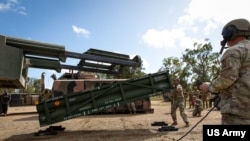Ukrainian officials this week renewed calls to allies for more military equipment and supplies to battle invading Russian forces.
Following talks with German Foreign Minister Annalena Baerbock during her visit to Kyiv, Ukrainian Foreign Minister Dmytro Kuleba said he had stressed the urgency of getting Taurus cruise missiles to Ukraine as soon as possible, Reuters reported.
"You will do it anyway, it's just a matter of time, and I don't understand why we are wasting time. We could have achieved more and saved more lives of Ukrainian soldiers and civilians if we already had Taurus," Kuleba said in response to a question at the joint press conference.
Kuleba also requested ATACMS long-range missiles. As media reported this week, the Biden administration is close to making a decision on providing Ukraine with the Army Tactical Missile Systems.
ACTAMS would provide Ukraine with "extraordinary capabilities," Robert Hamilton, director of the Eurasia Program at the Institute for Foreign Policy Studies, told VOA’s Ukrainian service. The analyst believes that they would allow the Ukrainian Armed Forces to further weaken Russian logistics.
Despite facing Russian military superiority, Ukraine is making slow and steady headway in the east and south, liberating territory that Russian forces occupied last year.
Ukraine continues to show tangible results in recapturing areas from the Russians, State Department spokesman Matthew Miller said Monday.
“Obviously, war is difficult, and the Ukrainian military is facing dug-in, entrenched Russian forces. But ... we continue to assess that the Ukrainians are making progress in their counteroffensive, and we have confidence in the ability of their forces,” Miller said.
Since the start of the counteroffensive operation three months ago, Ukrainian forces have managed to regain nearly 270 square kilometers of territory, Deputy Minister of Defense Hanna Maliar told VOA.
Ukrainian officials, along with many military experts, link the slow progress of the counteroffensive to the strong Russian resistance and the slow pace or even reluctance of the Western partners to give Ukraine what they need to push back Russian forces.
“Military science says that you can attack only if you have more weapons and more troops than the person you are attacking,” Maliar pointed out. Ukraine has fewer fighters than Russia and significantly fewer weapons, she said.
“But, we took a risk when the enemy's superiority is measured not by kilometers or meters, but by the very fact of military superiority, and we are still advancing in such conditions, contrary to military science.”
Ukrainian military officials told VOA that Russia is subjecting Ukraine to 10 times more intense shelling than the Ukrainians can effectively counter, primarily because of ammunition shortages.
Just last week, in the eastern front areas of Bakhmut, Avdiyivka, Maryinka, Lyman, and Kupyansk, Russia bombarded Ukraine eight to 10 times daily. A Ukrainian military official told VOA that “there were 8,000 shellings from the Russian side, totaling 380,000 shells."
The challenges that Ukraine is facing are absolutely unprecedented, said former minister of defense Andriy Zahorodniuk. One of them is the Russian defense line. During the time of the occupation, Russia built three lines of defense on the occupied territory and laid mines in three layers, said Ukraine's deputy minister of defense.
Demining had to be done sometimes manually, she explained, and Ukrainian soldiers undergo special training to carry out demining during the offensive. She emphasized that “there is a really great need in Ukraine for the entire spectrum of demining.”
Another factor contributing to the slow progress — the Ukrainian inability to defend itself from the sky. “There is no safe place in Ukraine,” Maliar said, because the Russians launch missiles over the entire territory every day.
While Patriot systems provided by the U.S. helped to save lives, there are only enough of them to defend the capital and some strategic facilities. To make a difference on the front line, Ukraine needs military planes, like the F-16.
The vice chief of staff of the U.S. Air Force, General David Allvin, told members of the Senate Armed Services Committee on September 12 that the F-16 aircraft will be important for Ukraine in the long run when the Ukrainian Air Force fully integrates the new fighters into its armed forces.
Despite all the challenges, Ukrainians are resolute in their efforts to liberate their territory. Ukraine’s military intelligence chief Kyrylo Budanov told at a conference in Kyiv on September 9: “Combat actions will continue in one way or another. In the cold, wet, and mud, it is more difficult to fight. The fighting will continue. The counteroffensive will continue,” Budanov said.
Ukrainian soldiers and society are looking forward to the end of the war, but they are not looking forward to freezing the conflict line, a member of the defense committee in the Ukrainian parliament Solomiya Bobrowska told VOA.
She points out that Russia is not showing any sign of changing its goal to conquer Ukraine. Russia is increasing its production of ammunition.
“The Kremlin is showing the world and signaling our Western partners that they are ready to run a marathon. They have resources, to fight, but to fight not only with Ukraine but with the Western world, as it still remains one of its biggest enemies,” said a Ukrainian MP.
She is certain that Russia under President Vladimir Putin will never give up the idea of occupying Ukraine because it is existential for them. And Ukrainians are fighting for their very existence as a country.










